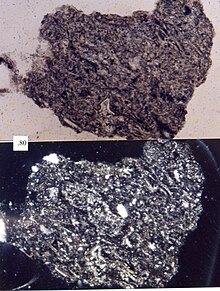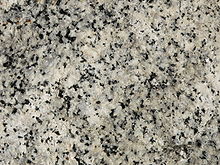Felsic
Ingeology,felsicis amodifierdescribingigneous rocksthat are relatively rich in elements that formfeldsparandquartz.[1]It is contrasted withmaficrocks, which are relatively richer inmagnesiumandiron.Felsic refers tosilicate minerals,magma,androckswhich are enriched in the lighter elements such assilicon,oxygen,aluminium,sodium,andpotassium.Felsic magma or lava is higher inviscositythan mafic magma/lava, and have low temperatures to keep the felsic minerals molten.
Felsic rocks are usually light in color and havespecific gravitiesless than 3. The most common felsic rock isgranite.Common felsic minerals include quartz,muscovite,orthoclase,and the sodium-richplagioclasefeldspars (albite-rich).
Terminology
[edit]Acid rock
[edit]In modern usage, the termacid rock,although sometimes used as a synonym, normally now refers specifically to a high-silica-content (greater than 63% SiO2by weight)volcanic rock,such asrhyolite.Older, broader usage is now considered archaic.[citation needed]That usage, with the contrasting term "basic rock" (MgO, FeO,mafic), was based on an ancient concept, dating from the 19th century, that "silicic acid"(H4SiO4or Si(OH)4) was the chief form of silicon occurring in siliceous rocks. Although this intuition makes sense from anacid-baseperspective inaquatic chemistryconsidering water-rock interactions and silica dissolution, siliceous rocks are not formed by this protonated monomeric species, but by a tridimensional network of SiO44–tetrahedra connected to each other. Once released in water and hydrolyzed, these silica entities can indeed formsilicic acidin aqueous solution.
Etymology
[edit]The term "felsic" is a derivation of the words "feldspar "and"silica ".[2]The similarity of the resulting termfelsicto the Germanfelsig,"rocky" (fromFels,"rock" ), is accidental.Feldsparis from the GermanFeldspat,acompoundof the GermanFeld,meaning field, plusspat[h],meaning mineral.[3]
Classification of felsic rocks
[edit]
In order for a rock to be classified as felsic, it generally needs to contain more than 75% felsic minerals (namely quartz,orthoclaseandplagioclase). Rocks with greater than 90% felsic minerals can also be calledleucocratic,[4]from the Greek words for white and dominance.
Felsiteis apetrologicfield term used to refer to very fine-grained oraphanitic,light-coloredvolcanicrocks which might be later reclassified after a more detailed microscopic or chemical analysis.
In some cases, felsic volcanic rocks may containphenocrystsofmaficminerals, usuallyhornblende,pyroxeneor a feldspar mineral, and may need to be named after their phenocryst mineral, such as 'hornblende-bearing felsite'.
The chemical name of a felsic rock is given according to theTAS classificationof Le Maitre (1975). However, this only applies to volcanic rocks. If the rock is analyzed and found to be felsic but ismetamorphicand has no definite volcanicprotolith,it may be sufficient to simply call it a 'felsic schist'. There are examples known of highlyshearedgranites which can be mistaken for rhyolites.
Forphaneriticfelsic rocks, theQAPF diagramshould be used, and a name given according to thegranitenomenclature. Often the species of mafic minerals is included in the name, for instance, hornblende-bearing granite,pyroxenetonaliteoraugitemegacrysticmonzonite,because the term "granite" already assumes content with feldspar and quartz.
The rock texture thus determines the basic name of a felsic rock.


| Rock texture | Name of felsic rock |
| Pegmatitic | Granitepegmatite |
| Coarse-grained (phaneritic) | Granite |
| Coarse-grained andporphyritic | Porphyriticgranite |
| Fine-grained (aphanitic) | Rhyolite |
| Fine-grained and porphyritic | Porphyriticrhyolite |
| Pyroclastic | Rhyolitictufforbreccia |
| Vesicular | Pumice |
| Amygdaloidal | None |
| Vitreous (Glassy) | Obsidianor porcellanite |
See also
[edit]- QAPF diagram
- List of minerals
- List of rock types
- Bowen's reaction series
- Archean felsic volcanic rocks
Notes
[edit]- ^Marshak, Stephen, 2009,Essentials of Geology,W. W. Norton & Company, 3rd ed.ISBN978-0393196566
- ^"felsic, adj".Oxford English Dictionary.2023.doi:10.1093/OED/1115329128.Retrieved14 June2024.
- ^Harper, Douglas."feldspar".Online Etymology Dictionary.Retrieved2008-02-08.
- ^Aurora Geosciences Ltd."Technical report Mackenzie mountains iron-copper property, Northwest Territories, Canada"(PDF).Archived(PDF)from the original on 2017-10-10.
References
[edit]- Le Maitre, L. E., ed. 2002.Igneous Rocks: A Classification and Glossary of Terms2nd edition, Cambridge
